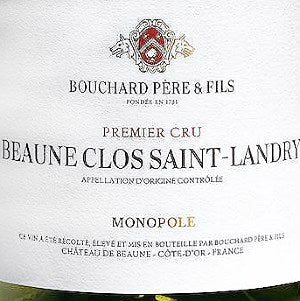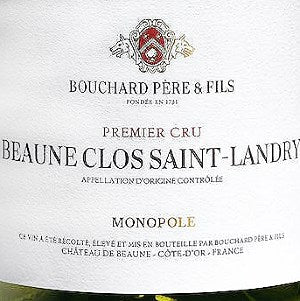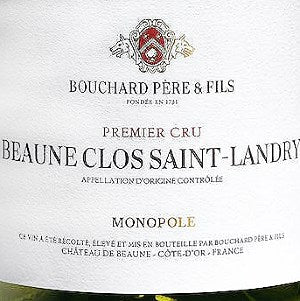
Domaine Bruno Clair Chambertin Clos de Beze Grand Cru Burgundy France, 2018, 750
Domaine Bruno Clair Chambertin Clos de Beze Grand Cru Burgundy France, 2018, 750
From the importer:
- Size: 0.98 ha (2.42 ac)
- Variety: Pinot Noir
- Vine Age: 2/3 planted in 1912, 1/3 in 1972
- Terroir: Extended on slope: poor stony soil at top, rich clay soil at bottom
- Viticulture: Organic methods (not officially certified)
- Vinification: 30% whole-cluster, indigenous yeast fermentation in open wooden tanks, minimal punch-downs and pump-overs (one each per day in general). Aged for 18 months in barrel (up to 30% new oak).
Etymology:
Chambertin: from Champ de Bertin, Bertin’s field.
Clos de Bèze: because it belonged to the monastery of Bèze.
Jasper Morris: “Chronologically, Clos de Bèze comes first: the monastery of Bèze, north of Dijon, received a donation of existing vineyards here shortly after its foundation in in 630, whereas Monsieur Bertin, who owned the fields which now bear his name, came later. The first surviving reference to Chambertin dates to the 13th century, when Guillaume de Grancey swapped some vines in Champ Bertin with the Abbey of Cluny in 1276.”
Site Description:
Chambertin Clos de Bèze is a 15.4 ha grand cru vineyard. Clos de Bèze may be called Chambertin, but not vice versa.
This vineyard has a moderate to gentle east-facing slope with many small ripples and waves that interrupt the concavity of the slope, creating several gentle pockets as opposed to one large belly. The variability of the topography is likely influenced by a patchwork of faults and microfaults beneath the surface. The north end of Clos de Bèze dips towards the north.
Clos de Bèze has an 11% average slope gradient, which is quite gentle compared to 17% gradient in Clos Saint-Jacques, but it is slightly steeper than Chambertin. Its elevation is 275 to 300 meters; 310 meters for that little bit at the southwest corner at the very top of the slope where the rows run NS.
It is a warmer terroir than Chambertin because the latter has cooler breezes coming from the Combe Grisard above.
Soil:
Premeaux limestone at the top of the slope produces a very thin, pinkish-tan, rocky soil. These light colored soils quickly gain color and texture as they progress downslope, until they become deep, dark brown, water-retentive, clay-rich soils at the bottom. These darker, lower soils are even richer and heavier than at the bottom of Le Clos Saint-Jacques.
The soils are rocky from top to bottom, with a beautiful array of limestone fossils everywhere you look. Pieces of large, fully intact shell fossils can be found amongst the pink Premeaux limestone, from the white oolite from up the slope, and beautiful examples of the small crinoid, or sea lily, fossils are scattered amongst the old vines.
Bedrock:
The top half of Clos de Bèze consist of a thin band of hard, unfractured, pink Premeaux limestone followed by a larger band of hydraulic limestone.
The bottom half consists of a thin band of ostrea acuminata marl which does not extend all the way to the north of the vineyard; and finally, at the bottom of the slope, there is a large band of fossiliferous Crinoidal limestone.
The Clair parcel:
It is 0.98 ha located in the northern third of the vineyard before it dips north. Two thirds of the vines were planted in 1912 (with narrower and more irregular rows than is customary today, and therefore with slightly higher density) and the rest in 1972. The rows go the entire slope and Bruno’s example is a complete expression of the terroir.
With many thanks to geologist Brenna Quigley for putting the physical and geological aspects of these vineyards into words far more meaningful than we could have written on our own. www.brennaquigley.com
Decanter 95
"Bruno Clair owns 1ha of Clos de Bèze, which is quite a lot given how extensive Pierre Damoy's holdings are in the grand cru. This is a comparatively subtle, gentle wine rather than a late-picked blockbuster, with attractive 40% new wood, some chalky zip and nuanced red fruit sweetness."
Vinous 93-95
"The 2017 Chambertin Clos-de-Bèze Grand Cru has a well-defined bouquet of broody black fruit (like the Clos Saint-Jacques) and traces of the sea – kelp and estuary mud flats – loitering in the background. The palate is medium-bodied with fine-grained tannin. This is very well balanced, displaying impressive substance, sea-salt-lacquered black fruit and a tangy, very mineral-driven finish that fans out beautifully. Superb."
Burghound 93
"An overtly floral, more elegant and airier nose displays a striking array of spice elements on the red and dark currant, herbal tea, earth and lavender scents. Here too the mouthfeel of the larger-scaled flavors is quite sophisticated while displaying plenty of punch on the youthfully austere finale that also flashes a touch of bitter fruit pit character. Lovely stuff."
From the producer
- GRAPE VARIETYPinot Noir
- ACREAGE0.9802 hectare
- SoilClay limestone
- ORIENTATIONSouth-east
- AVERAGE ALTITUDE280m
- YEAR OF PLANTING1912, 1974, 1987
- Vinification30–50% whole bunches; 10–15 days maceration in wooden vats
- MATURATION18–20 months in oak barrels; approx. 40% new barrels
-
TASTING NOTESDeep red robe
Nose of black fruits and spices
Silky tannins, impressive length and complexity
- LAYING DOWN7/8 years minimum




